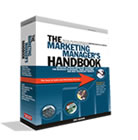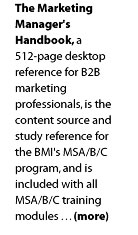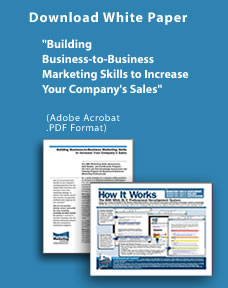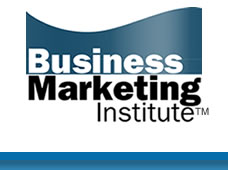

 Tuesday Marketing Notes (Number 3—October 11th, 2005)
Tuesday Marketing Notes (Number 3—October 11th, 2005)
A B2B Marketing Newsletter for BMA Members
____________________________________________________________
Getting Better Sales Copy: Three-Step Sales Copy Outline Exercise for Marketing Managers
by Eric Gagnon
As a marketing manager, you work with your ad agency, copywriter, or outside marketing consultant to develop ads, mailings, Web site copy, flyers and other marketing deliverables for the various projects in your marketing program.
Should you provide these vendors with some guidance on the sales benefits that need to appear in these marketing pieces? If so, then how do you determine the sales benefits to be featured in these pieces, and how do you decide which of these benefits are more important than others?
Providing a sales copy outline of your product’s major sales benefits to your copywriter insures that your product’s key sales benefits appear in the final deliverable, and increases the effectiveness of that final ad, mailing or other deliverable.
By leading the copywriting process, you also eliminate the dangers of “black box mentality”—that is, handing total control over the presentation of your product’s major sales benefits to others, without providing any guidance to them on the front end of the copywriting process.
Most important, specifying your product’s most compelling sales benefits, and passing these along to your copywriter substantially increases the chance your ad, mailing, or other marketing deliverable clearly and effectively presents your product’s benefits, and helps to remove the doubt that this deliverable could have done a better job of selling your prospect.
And removing this doubt assures you that any failure in a marketing project was not caused by a marketing deliverable that didn’t express the benefits of your company’s products in a clear or persuasive way.
Eliminating this doubt also gives you one less thing to worry about when you’re trying to troubleshoot the causes of a marketing project that didn’t generate the sales response you’d hoped for.
Three-Step Copywriting Starts with a Pencil and Three Sheets of Paper
To develop a sales copy outline, I use a three-step process that documents all of a product’s sales benefits, and reveals the benefits which are most important to the task of selling your product.
As a marketing manager, you can use this process to create your own sales copy outline that can be used for any marketing deliverable.
To begin, take out a pencil and three sheets of paper.
On the first sheet, write this header at the top of the page:
Laundry List
…on the second sheet, write this header:
Park Bench Story
…and on the third sheet, write this header:
Elevator Pitch
The Laundry List
The first step in the process is what I call the Laundry List, which is nothing more than a long list of all the sales benefits you can think of about your company's product or service.
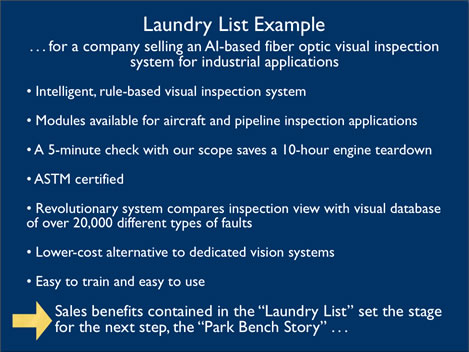
Write all of the benefits for your product or service down on your first sheet of paper. The purpose here is just to get every sales benefit down on paper—at this point, it's not important to assign importance to any one benefit over another.
Sales Benefit Attribute Ideas
To get you started on your own Laundry List, here are some important sales benefit attributes you can use to spark your own process of developing the sales benefits you use in your own company's advertising:
Speed • Efficiency • Productivity
The first group of benefits are related to speed, efficiency, and productivity. For example, what is it about your company's product that makes it perform faster, more efficiently, or more productively than your competitors' products?
What is it about your company's product that helps your prospect get more work done, or get this work done more efficiently?
Can you measure this productivity using numbers, such as fuel savings, or number of additional units produced per hour?
What other ways would a prospective buyer of your company's product be better off compared to the “old ways” he’s doing business today?
Write down any benefits related to speed, efficiency, or productivity relating to your company's product or service.
Quality • Comprehensiveness • Richness
The next set of benefits relate to the quality, comprehensiveness, and richness of your product. For example, what is it about your product’s quality that makes it better than that of your competitors? Are there key parts or processes relating to your company's products or services, such as better materials construction or manufacturing processes, that improve their function and durability? If so, then what are they, and how are they better than your competitor’s products? If your company provides a service, then how experienced are those in your company who provide this service?
Do some major, well-known companies use your product or service? Would some of these companies be willing to provide testimonials on your company's products for use in your company’s advertising?
How broad is your product line? Can it solve all of the prospect’s problems in the area of where he needs your product?
Low Cost • Savings • Value for Money
The next set of benefits relate to your product’s low-cost, savings, or value-for-money characteristics. For example, can your prospect save money or reduce their costs by using your company's product or service? If so, then how much can they save?
How would your prospect be better off by using your product—for example how would their business improve by saving money or by being more productive if they used your company's product? Here, it helps if you can provide specific numbers to back up your claims—for example, how much current customers save, on average.
Can you make a special price offer on your product, so a prospect can save money on their first order? If so, then what's that offer?
Savings, low-cost, and value propositions are very compelling sales benefits to prospects, so write down as many of these as you can.
New • Updated • Improved • Different
The next set of benefits relate to how new, updated, improved, or different your product is compared to those of your competitors. For example, are you marketing a new product? If so, then how is it different or better than current products?
Has your product been updated from a previous model? If so, then what are the advantages of these upgrades? Are there aspects of these improvements that are radical, or may change the way your prospect does business? If so, then try linking these ways to the more familiar ways your prospect already does business, or does their job. Describe how your company's new approach is better than your prospect’s current approach.
Step Two: The Park Bench Story
The sales benefits you write down in your Laundry List set the stage for the next step in this exercise, the Park Bench Story, a long-form narrative or story about your company's product or service.
To begin, describe your product and its benefits informally, as if you're telling them for the first time to a stranger. Tell this stranger how would they would benefit by using your product. Is your product useful only to people who work in certain types of businesses or industries? How does your product work? Use analogies to explain or simplify complex product features that wouldn't be readily understood by the average person, and also probably by the average prospect in your market.
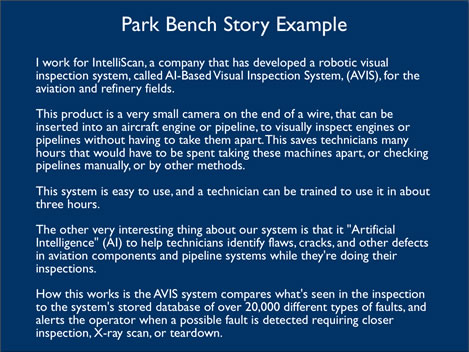
Explain so that a perfect stranger could understand how he or she could use your company's product. Explain where they could find this product, and how they can buy it. Write this down—tell the story about your company's product in a conversational way, including the essential facts we've just described.
Step Three: The Elevator Pitch
Once you've written your Laundry List and Park Bench story, you’re now ready for the third and final step, which is writing your product’s Elevator Pitch. This is where you condense the essential benefits of your product into a very short, concise sales pitch that answers these four questions:
Who is your company?
What does your company sell?
What's so good about that?
What’s in it for me?
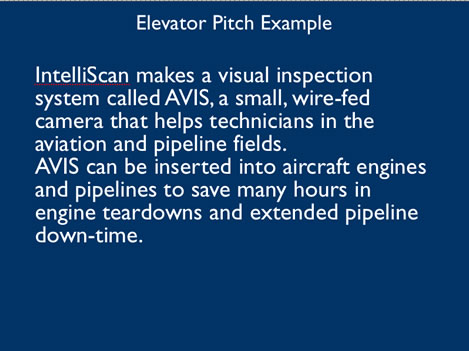
The Elevator Pitch is your most forceful, compelling two- or three- sentence statement on your company and its products.
Putting it All Together: Creating an Ad from Sales Copy Benefits
Now we’ll describe how this three-step process can be used to create an ad. Once you've written your Laundry List, your Park Bench story, and your Elevator Pitch, you can match the benefits you’ve developed in these exercises to each of the essential key elements of a typical print ad—headline, subhead, body copy, and call to action.
First, find any benefits that repeat themselves across all three of these writing exercises—the Laundry List, the Park Bench Story, and Elevator Pitch.
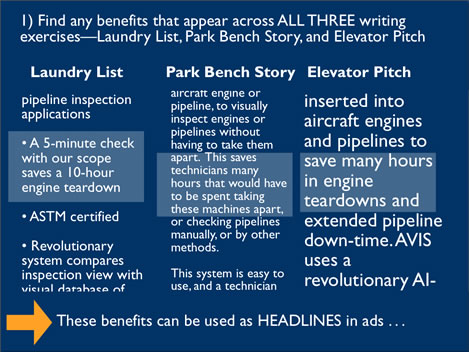
Because these benefits are significant enough to have found their way into all three copywriting forms, they’re usually strong enough to be used as headlines in your ads.
Next, find any sales benefits that appear in any two of these three exercises. These benefits are important enough to be used in subheads for your ads.
The key sales points from the long-form Park Bench Story can be used as the basis for writing body copy in ads, brochures, or other marketing deliverables.
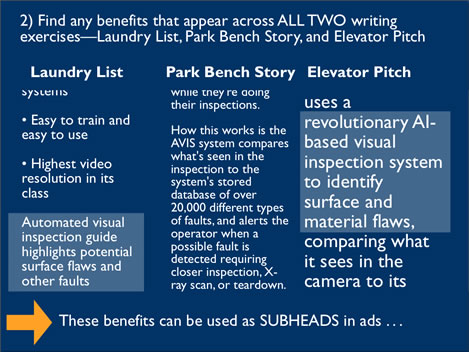
Any special offer or command to “buy it now” you find in your Park Bench Story or any of the other two exercises can be used as the call to action in your ad.
![]()
A side benefit of this three-step copywriting process is that it also helps you write about your company's products in three copy lengths—short, medium, and long.
The Elevator Pitch is the short form of your product’s sales benefits, the Laundry List is the medium form, and the Park Bench Story is the long-form copy version of your product’s sales benefits.
This three-step process helps you write a sales copy outline for any copy space, whether it’s a small fractional ad in a trade publication, or larger full-page ad, or a single paragraph description on your product for a publication or press release.
Creating the Sales Copy Outline
After you’ve worked through this three-step exercise, create the final sales copy outline by organizing these notes into a single list broken down into three parts: Major sales copy benefits (such as those uncovered for headlines described previously), secondary benefits, and any promotional offers or other inducements for the prospect to “act now.” The final product is a simple, sorted compilation of the sales benefit bullet points you’ve documented from this exercise.
Writing a sales copy outline helps give your ad agency or copywriter the guidance and direction they need for their own copywriting efforts, by giving them a thoughtfullly-developed outline list of your product's major sales benefits.
The sales copy outline helps your agency or copywriter do a better job of delivering your product’s essential sales benefits in the advertising or other marketing pieces they create for your company. Your sales copy outline is not a hard-and-fast blueprint for the final ad, but a general set of guidelines and “idea starters” for your agency to use for their own independent copywriting and creative efforts.
As a marketing manager, you won’t usually be the one writing ad copy for your company, but this process will help you to create a sales copy outline for your ad agency that gets everyone on the same page, and helps insure your product’s most compelling sales benefits will appear in the final print ad or marketing deliverable.
Most important, this process goes a long way toward eliminating the doubt that an ad campaign, mailing or other marketing project could have expressed your product’s most compelling benefits to the prospect more clearly, or more persuasively.
Next week, we’ll cover everything you need to know about advertising design and layout (honest!)
Comments? Suggestions? Send them to me at eric@realmarkets.net
_____________________________________________________________
Eric Gagnon (eric@realmarkets.net), is president of GAA, a sales and business development consulting firm, and is the author of The Marketing Manager’s Handbook, the master study guide for the Business Marketing Association’s Marketing Skills Assessment, Skill Builder, and Certification (MSA/B/C) programs.
For more information on The Marketing Manager’s Handbook, available to BMA members at a special discount, link to:
http://www.businessmarketinginstitute.com/book.html
_____________________________________________________________
Test, Train, and Build Your B2B Marketing Skills for Better Sales Success: BMA Announces New Assessment, Training, and Certification for B2B Marketing Managers
For more information on the new BMA Marketing Skills Assessment, Skill Building and Certification (MSA/B/C) training and professional development program, visit http://www.businessmarketinginstitute.com
